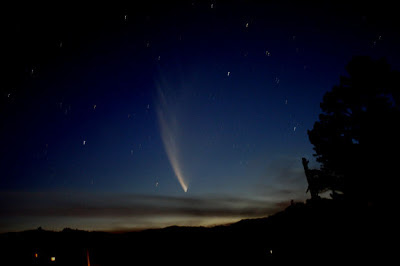Young Earth Evidence 8: Short-Term Comets
We've been looking downward at evidence for a young Earth, now we can lift our eyes to the heavens.
Specifically, short-term comets. Most of us learned long ago that comets are wanderers in space that are rock and ice ("dirty snowballs"). When they get close enough to the sun, they begin to burn off some of their material and produce those dramatic tails. After enough loops through the solar system, they eventually burn away. Or crash into planets. Or get tossed out of the solar system entirely.
Using evolutionary cosmologists' uniformitarian assumptions against them, we find that all of the comets should have been used up a long time ago. They have some interesting rescuing devices that do not hold together.
 |
| morgueFile/seriousfun |
Using evolutionary cosmologists' uniformitarian assumptions against them, we find that all of the comets should have been used up a long time ago. They have some interesting rescuing devices that do not hold together.
A comet spends most of its time far from the sun in the deep freeze of space. But once each orbit a comet comes very close to the sun, allowing the sun’s heat to evaporate much of the comet’s ice and dislodge dust to form a beautiful tail. Comets have little mass, so each close pass to the sun greatly reduces a comet’s size, and eventually comets fade away. They can’t survive billions of years.
Two other mechanisms can destroy comets—ejections from the solar system and collisions with planets. Ejections happen as comets pass too close to the large planets, particularly Jupiter, and the planets’ gravity kicks them out of the solar system. While ejections have been observed many times, the first observed collision was in 1994, when Comet Shoemaker-Levi IX slammed into Jupiter.You can finish reading this short, layman's-level article at "Short-Lived Comets". If, however, you want "lengthy" and "technical", you can read "Comets and the Age of the Solar System".